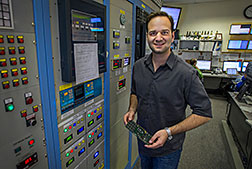- Number 436 |
- April 6, 2015
A tale of two colliders

Dennis Perepelitsa in the PHENIX control
room.
Dennis Perepelitsa, a Brookhaven Lab physicist exploring the mysteries of nuclear physics at the Relativistic Heavy Ion Collider (RHIC) and the Large Hadron Collider (LHC), has the distinction of being the first person to earn outstanding Ph.D. thesis awards from both research communities. His Ph.D. work, based on complementary data collected at the PHENIX and ATLAS detectors at these two particle colliders, showcased intriguing findings that have upturned physicists’ understanding of something they thought they knew well—an ongoing mystery that is guiding part of the research programs at both machines now.
“I’ve been very lucky to work on these two world-class experiments with leaders in the field as my advisors,” Perepelitsa said. “When I started out working on PHENIX/RHIC, we observed some very strange features in the data, and went to the LHC to look for answers to the puzzling results. Now we’re taking what we learned at the LHC and reinvesting that knowledge back into this year’s RHIC run.”
The mystery arose when Perepelitsa began analyzing data collected during RHIC’s 2008 run colliding deuterons—a simple nucleus made of one proton and one neutron—with much larger gold nuclei (with 197 protons and neutrons). The goal was to use the smaller deuterons to probe the structure of the larger nuclei by measuring high-energy quark and gluon jets. “Our thinking was that since the small particle, the deuteron, was well understood, we’d use it to learn something about the … larger nucleus,” Perepelitsa said. “And then everything broke down.”
The data didn’t fit with expectations of what physicists thought they’d see in these collisions based on past experience. So Perepelitsa and others took the mystery to ATLAS, which had different capabilities from PHENIX, to analyze the results of proton-lead collisions there. The results revealed the same breakdown of the models. But with more ‘knobs’ to turn at ATLAS, “we could try to see if there was a … way to explain what we were seeing.”
The explanation turned out to be another surprise: The failure of the geometric models appeared to come from an unexpected effect in the proton or the deuteron.
“The patterns in the data indicated that the smaller, supposedly understood component of these collisions was the controlling factor,” Perepelitsa said.
Physicists are still evaluating possible explanations and thinking through the implications for other scientific questions—and refining the next round of experiments. In about a month, RHIC will produce its first-ever collisions of polarized protons with gold and then aluminum nuclei, with brand new detector components in place at PHENIX that will be sensitive to these effects.
“Perepelitsa’s analysis and the continuing role he plays in both the PHENIX and ATLAS experiments is a classic example of the complementary nature of the research taking place at these two facilities,” said Brookhaven Lab physicist Dave Morrison, a current co-spokesperson of PHENIX and Perepelitsa’s supervisor. “It also highlights the far-reaching opportunities the international nuclear physics research community offers for young physicists interested in this field.”
Full story: http://www.bnl.gov/newsroom/news.php?a=25523.[Karen McNulty Walsh, 631.344.8350,
kmcnulty@bnl.gov]
